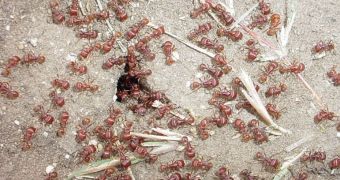Analyzing the social behavior of insects is one of the main avenues of research today, as experts hope that sequencing genomes of ants and other creatures might shed some insight into what makes communities and groups stick together.
Understanding the evolution of complex societies, such as those formed by termites and other species, has been a goal in science for many years. Thus far, progress on this front has been slow, experts say, but new data are now beginning to pour in.
Sequencing studies are currently heralded as one of the primary approaches for making headway into figuring out complex societies. The most recent study of this kind was done on red harvester ants.
The genome of the species, called Pogonomyrmex barbatus, was analyzed in great detail, and the full details of the research appear in this week's Early Edition of the esteemed journal Proceedings of the National Academy of Sciences (PNAS).
Researchers led by expert Juergen Gadau carried out the study with the express purpose of figuring out which genes determine the fate of the ants. Some of them are destined for a life of work, whereas others are recruited for reproduction and supporting the colony
As the study neared its end, the study team determined that the evolution of social structures is heavily reliant on two critically-important things, the division of labor and reproduction.
Gadau, a professor of organismal and systems biology, conducted the Arizona State University (ASU) group that conducted the investigation. He is also the author of the PNAS research paper.
“Having multiple independently evolved social genomes helps us to better understand which genes are involved in crucial social traits, because those should be highly conserved,” the team leader explains.
Eusociality – the type of collaboration exhibited by ants, bees and termites – is an extreme form of social behavior, the team says, that was conditioned by the development of various methods for communicating information within the species.
This research was funded by the US National Science Foundation's (NSF) Biology Directorate Division of Integrative Organismal Systems.
“The diversity in social structure between the different ants sequenced will allow us to search for the genetic basis and the architecture underlying the observed social diversity in ants,” Gadau says.
“A comparison with bees, a completely independent evolutionary lineage, will give us an opportunity to test whether there are multiple ways how a genome can become a sociogenome,” he adds.

 14 DAY TRIAL //
14 DAY TRIAL //